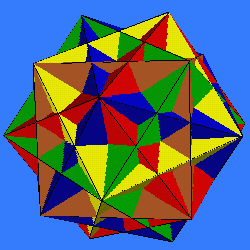Virtual Polyhedra
The Encyclopedia of Polyhedra
 Introduction
Introduction
- Welcome to this collection of thousands of virtual reality polyhedra
for you to explore. I hope you enjoy playing with them as much as I enjoyed
making them. There are hundreds here which have never been illustrated
in any previous publication.
Polyhedra have an enormous aesthetic appeal and the subject is fun and easy to learn on one's own. One can appreciate the beauty of this image without knowing exactly what its name means --- the compound of the snub disicosidodecahedron and its dual hexagonal hexecontahedron --- but the more you know about polyhedra, the more beauty you will see.
This site is a free self-contained easy-to-explore tutorial, reference work, and object library for people interested in polyhedra. You may choose to simply view the virtual objects for their timeless, serene aesthetics, or to read the related mathematical background material at various levels of depth. Of course, as an academic type, I feel obliged to include a few exercises. And as it says in the textbooks, you'll learn a lot more if you work on the exercises yourself before looking at the solutions.
I believe the best way to learn about polyhedra is to make your own paper models or other models. The second best is to play with a set someone else has made. You can do that here because you can look at, move, and spin these models which I have made for you. And in one respect, virtual models have an advantage: you can travel inside them to gain a perspective not possible in paper models. After exploring my virtual models, I hope you choose to make some of your own paper models.
This work is complementary to my Pavilion of Polyhedreality, which you may wish to visit to find additional information on polyhedra and links to other related material. You may also like my polyhedra-based geometric sculpture.
Historical Background
- I originally created this website in the mid-1990's, when the internet
was new and Wikipedia and other references didn't yet exist. Technology for
displaying 3D models at the click of a mouse
became available and I decided that writing a reference site about
polyhedra would be a good application for it. Over the three intervening
decades, the technology and the software standards evolved considerably.
I kept the site functioning for some years then decided it was taking
more time than it was worth to follow the currents of ever-changing
software and file formats. So for twenty years or so, this site was
effectively nonfunctional for most viewers. But recently Scott Vorthmann
offered to update the viewing technology and make the 3D models
visible again in all modern browsers. This is a beta test of his
new viewer. (Thank you, Scott, and thank you Jacob Petersen for converting
my original files to VRML 2.0) If everything remains stable and functional, I will
start to update some of the content.
 You should be able to click on the picture at right and see a 3D version
of this compound of five
cubes in the main viewing window. First study the object, spin it around,
and see it as five interpenetrating cubes, one in each color. Then, imagine
what you would see if you were sitting at the center of this object. This
is the same as asking what the intersection of the five cubes looks like.
(Hint: how many sides must it have ?) After you imagine the view
from the center, use the viewer to travel to the inside
of the compound of five cubes. What do you see ? Answer.
You should be able to click on the picture at right and see a 3D version
of this compound of five
cubes in the main viewing window. First study the object, spin it around,
and see it as five interpenetrating cubes, one in each color. Then, imagine
what you would see if you were sitting at the center of this object. This
is the same as asking what the intersection of the five cubes looks like.
(Hint: how many sides must it have ?) After you imagine the view
from the center, use the viewer to travel to the inside
of the compound of five cubes. What do you see ? Answer.
Before going on too far, you may also want to read about:
Table of Contents
Platonic Solids (Regular Convex Polyhedra)
- Background --- List
of models
Kepler-Poinsot Polyhedra (Regular NonConvex Polyhedra)
- Background --- List
of models
Archimedean Polyhedra (Semi-Regular Convex Polyhedra)
- Background --- List
of models
Prisms and Anti-Prisms
- Background --- List
of models
Archimedean Duals
- Background --- List
of models
Quasi-Regular Polyhedra
- Background --- List
of Models
Johnson Solids (the remaining convex polyhedra with regular faces)
- Background --- List
of models
Pyramids, Dipyramids, and Trapezohedra
- Background --- List
of models